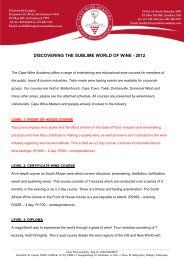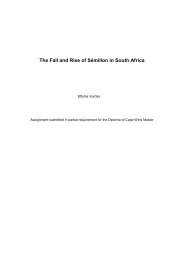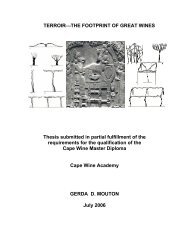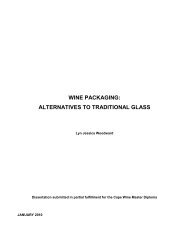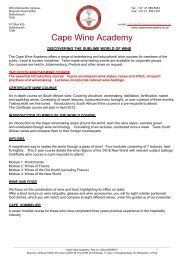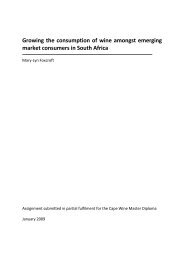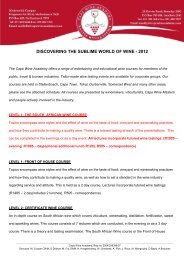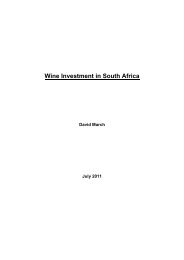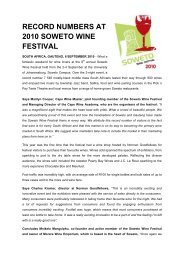micro-oxygenation in contemporary winemaking - Cape Wine ...
micro-oxygenation in contemporary winemaking - Cape Wine ...
micro-oxygenation in contemporary winemaking - Cape Wine ...
You also want an ePaper? Increase the reach of your titles
YUMPU automatically turns print PDFs into web optimized ePapers that Google loves.
Micro-<strong>oxygenation</strong> <strong>in</strong> Contemporary W<strong>in</strong>emak<strong>in</strong>g5.3.2 Newer InnovationsAlthough the basic technology described <strong>in</strong> Section 5.3.1 has been around for more than15 years now, it rema<strong>in</strong>s the standard approach to <strong>micro</strong>-<strong>oxygenation</strong> around the world.Some newer methodologies that may become more important, and more widespread, <strong>in</strong>future <strong>in</strong>clude:1. Diffusion methods: O 2 mate and (barrel)mate2. Oxygen-permeable tanks: Flextank3. Electro-chemical <strong>micro</strong>-<strong>oxygenation</strong>.Diffusion methods are based on the diffusion of oxygen across a permeable membrane<strong>in</strong>stead of the usual bubbl<strong>in</strong>g method (Kelly and Wollan, 2003; Paul and Kelly, 2005). Thetechnique was <strong>in</strong>vented by Mark Kelly of W<strong>in</strong>e Network Australia and is distributed byMemstar under the brand name of O 2 mate (Memstar, 2008). The technique depends onspecialised polydimethylsiloxane tub<strong>in</strong>g which is permeable to oxygen and will not clog up.The tub<strong>in</strong>g is placed <strong>in</strong>side the maturation tank and connected to an un-pressurised systemsupply<strong>in</strong>g atmospheric oxygen at the required dose.It is argued that the <strong>micro</strong>scopic bubbles produced by diffusion are a much better way ofdeliver<strong>in</strong>g oxygen <strong>in</strong>to w<strong>in</strong>e than the large bubbles produced by traditional methods, andthat the system mimics more closely the diffusion of oxygen that occurs dur<strong>in</strong>g normalbarrel age<strong>in</strong>g (Paul and Kelly, 2005). Because headspace accumulation of oxygen is not aproblem with diffusion technology, one advantage of the system is that it doesn’t require apath length of 2.2m and can therefore be used <strong>in</strong> smaller tanks. Indeed, W<strong>in</strong>e Networkhave also developed a <strong>micro</strong>-<strong>oxygenation</strong> solution for use <strong>in</strong> barrels called (barrel)mate.Kelly and Wollan (2003) calculate that the maximum amount of oxygen diffusion that canoccur with normal barrel maturation is only 2.5 ml/L/month whereas some w<strong>in</strong>e requires upto 8 ml/L/month for optimal polymerisation reactions. The (barrel)mate system is able toprovide the supplementation required. The diffusion technology is the subject of an<strong>in</strong>ternational patent and is currently undergo<strong>in</strong>g large scale commercial trials.Even more <strong>in</strong>trigu<strong>in</strong>g are the oxygen-permeable tanks developed by Flextank <strong>in</strong> 2004(Flecknoe-Brown, 2004; Flecknoe-Brown, 2005; Flecknoe-Brown, 2006). These w<strong>in</strong>ematurationvessels are made from high density polyethylene which is permeable to oxygenso that the vessels actually allow oxygen through the walls <strong>in</strong> a similar way to normal oakbarrels. The polyethylene tanks have been specially designed to limit the degradation ofw<strong>in</strong>e aroma compounds and to <strong>in</strong>hibit bacterial spoilage – problems typical of other plastictanks. The amount of oxygen delivered depends on the size of the tank but the oxygen22



